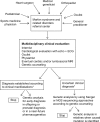Marfan syndrome: current perspectives
- PMID: 27274304
- PMCID: PMC4869846
- DOI: 10.2147/TACG.S96233
Marfan syndrome: current perspectives
Abstract
Marfan syndrome (MFS) is a pleiotropic connective tissue disease inherited as an autosomal dominant trait, due to mutations in the FBN1 gene encoding fibrillin 1. It is an important protein of the extracellular matrix that contributes to the final structure of a microfibril. Few cases displaying an autosomal recessive transmission are reported in the world. The FBN1 gene, which is made of 66 exons, is located on chromosome 15q21.1. This review, after an introduction on the clinical manifestations that leads to the diagnosis of MFS, focuses on cardiovascular manifestations, pharmacological and surgical therapies of thoracic aortic aneurysm and/or dissection (TAAD), mechanisms underlying the progression of aneurysm or of acute dissection, and biomarkers associated with progression of TAADs. A Dutch group compared treatment with losartan, an angiotensin II receptor-1 blocker, vs no other additional treatment (COMPARE clinical trial). They observed that losartan reduces the aortic dilatation rate in patients with Marfan syndrome. Later on, they also reported that losartan exerts a beneficial effect on patients with Marfan syndrome carrying an FBN1 mutation that causes haploinsufficiency (quantitative mutation), while it has no significant effect on patients displaying dominant negative (qualitative) mutations. Moreover, a French group in a 3-year trial compared the administration of losartan vs placebo in patients with Marfan syndrome under treatment with beta-receptor blockers. They observed that losartan decreases blood pressure but has no effect on aortic diameter progression. Thus, beta-receptor blockers remain the gold standard therapy in patients with Marfan syndrome. Three potential biochemical markers are mentioned in this review: total homocysteine, serum transforming growth factor beta, and lysyl oxidase. Moreover, markers of oxidative stress measured in plasma, previously correlated with clinical features of Marfan syndrome, may be explored as potential biomarkers of clinical severity.
Keywords: Marfan syndrome; cardiovascular manifestations; diagnosis; fibrillin 1; therapy; thoracic aortic aneurysm.
Figures


References
-
- Ramirez F, Dietz HC. Marfan syndrome: from molecular pathogenesis to clinical treatment. Curr Opin Genet Dev. 2007;17(3):252–258. - PubMed
-
- Loeys BL, Dietz HC, Braverman AC, et al. The revised Ghent nosology for the Marfan syndrome. J Med Genet. 2010;47(7):476–485. - PubMed
-
- Beighton P, de Paepe A, Danks D, et al. International nosology of heritable disorders of connective tissue, Berlin, 1986. Am J Med Genet. 1988;29(3):581–594. - PubMed
-
- De Paepe A, Devereux RB, Dietz HC, Hennekam RC, Pyeritz RE. Revised diagnostic criteria for the Marfan syndrome. Am J Med Genet. 1996;62(4):417–426. - PubMed
Publication types
LinkOut - more resources
Full Text Sources
Other Literature Sources

